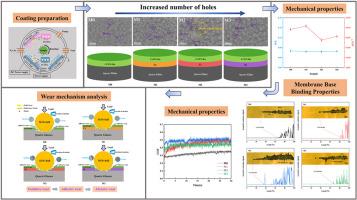石英玻璃基板上Cr、Ti和Si夹层CrWN-Ru涂层的力学和摩擦学性能研究
IF 4.7
3区 材料科学
Q2 MATERIALS SCIENCE, MULTIDISCIPLINARY
引用次数: 0
摘要
鉴于石英玻璃作为精密玻璃成型(PGM)模具材料的潜在应用,本研究旨在评估使用CrWN-Ru涂层用于保护目的的可行性。重点研究了Cr、Ti和Si夹层对提高CrWN-Ru涂层体系使用性能的影响。采用等离子体增强磁控溅射技术在石英玻璃衬底上沉积CrWN-Ru、Cr/ CrWN-Ru、Ti/ CrWN-Ru和Si/ CrWN-Ru涂层。采用对比实验的方法研究了四种涂层体系的力学性能和摩擦学性能。结果表明,等离子体增强磁控溅射可以在石英玻璃衬底上制备出具有良好表面质量和结构稳定性的CrWN-Ru涂层。Cr、Ti和Si中间层的引入降低了涂层的表面质量,但没有改变其首选的晶体取向,而相结构保持稳定。同时,中间层的存在提高了CrWN-Ru涂层的硬度和杨氏模量,从而改善了涂层的整体强度-韧性平衡。在测试的体系中,含Cr中间层的涂层表现出最好的性能,具有最高的硬度(9.35 GPa)和杨氏模量(144.55 GPa),同时具有优异的韧性和薄膜-衬底附着力。相比之下,没有中间层的CrWN-Ru涂层表现出优异的摩擦学性能,摩擦系数和磨损率分别低至0.326和1.14 × 10−7 mm3/N·m。然而,观察到中间层的引入降低了CrWN-Ru涂层的耐磨性,并且随着中间层厚度的增加,这种不利影响变得更加明显。所有四种CrWN-Ru涂层都表现出相似的磨损损伤机制,其顺序为:摩擦-氧化-粘附-磨粒磨损-裂纹形成-分层。本研究为石英玻璃基板上CrWN-Ru涂层的设计、优化和性能定制提供理论指导,从而促进石英玻璃在精密玻璃成型领域的应用。本文章由计算机程序翻译,如有差异,请以英文原文为准。

Investigation of the mechanical and tribological properties of CrWN–Ru coatings with Cr, Ti, and Si interlayers on quartz glass substrates
In light of the potential application of quartz glass as a mould material for precision glass moulding (PGM), this study aims to evaluate the feasibility of employing CrWN–Ru coatings for protective purposes. Particular attention is given to the effect of Cr, Ti and Si interlayers on enhancing the service performance of the CrWN–Ru coating system. CrWN–Ru, Cr/CrWN–Ru, Ti/CrWN–Ru, and Si/CrWN–Ru coatings were deposited on quartz glass substrates using plasma-enhanced magnetron sputtering. A comparative experimental approach was adopted to investigate the mechanical and tribological properties of the four coating systems. The results demonstrate that plasma-enhanced magnetron sputtering enables the fabrication of CrWN–Ru coatings with satisfactory surface quality and structural stability on quartz glass substrates. The introduction of Cr, Ti, and Si interlayers was found to reduce the surface quality of the coatings without altering their preferred crystallographic orientation, while the phase structure remained stable. At the same time, the presence of interlayers enhanced the hardness and Young's modulus of the CrWN–Ru coatings, thereby improving their overall strength–toughness balance. Among the systems examined, the coating with a Cr interlayer exhibited the best performance, achieving the highest hardness (9.35 GPa) and Young's modulus (144.55 GPa), together with superior toughness and film–substrate adhesion. In contrast, the CrWN–Ru coating without an interlayer demonstrated excellent tribological behaviour, with the coefficient of friction and wear rate reaching as low as 0.326 and 1.14 × 10−7 mm3/N·m, respectively. However, the introduction of interlayers was observed to diminish the wear resistance of the CrWN–Ru coatings, and this adverse effect became more pronounced with increasing interlayer thickness. All four CrWN–Ru coatings were found to exhibit a similar wear damage mechanism, which proceeds through the sequence: friction - oxidation - adhesion - abrasive wear - crack formation - delamination. This study provides theoretical guidance for the design, optimisation, and performance tailoring of CrWN–Ru coatings on quartz glass substrates, thereby promoting the application of quartz glass in the field of precision glass moulding.
求助全文
通过发布文献求助,成功后即可免费获取论文全文。
去求助
来源期刊

Materials Chemistry and Physics
工程技术-材料科学:综合
CiteScore
8.70
自引率
4.30%
发文量
1515
审稿时长
69 days
期刊介绍:
Materials Chemistry and Physics is devoted to short communications, full-length research papers and feature articles on interrelationships among structure, properties, processing and performance of materials. The Editors welcome manuscripts on thin films, surface and interface science, materials degradation and reliability, metallurgy, semiconductors and optoelectronic materials, fine ceramics, magnetics, superconductors, specialty polymers, nano-materials and composite materials.
 求助内容:
求助内容: 应助结果提醒方式:
应助结果提醒方式:


